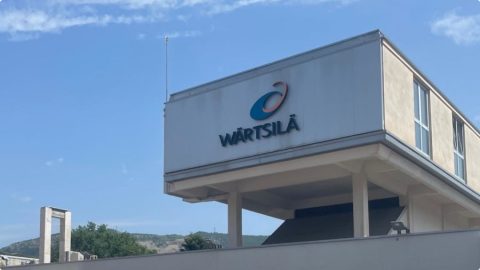RailFreight Summit 2019 – Liveblog Day 2

Thursday 16 May is the second day of the RailFreight Summit 2019, taking place in the Polish city of Gdansk. Today’s discussions are dedicated to intermodal hubs in Poland and the emerging rail markets in Central Eastern Europe. The liveblog of the first day is available here.
15.15: The RailFreight Summit 2019 is over. Arie van Dijk, Commercial Director of ProMedia Group, reminds that the event takes place in Poland for the second time. “Last year we were in Wroclaw, now we are in Gdansk, and we are very happy to be here. I hope you had two good days to discuss rail freight logistics and make new contacts. Now, we are thinking about the location for next year. It can be Poznan or Łódź, or another place in Poland. See you next year again in Poland!” he concludes.
Text continues below the picture.
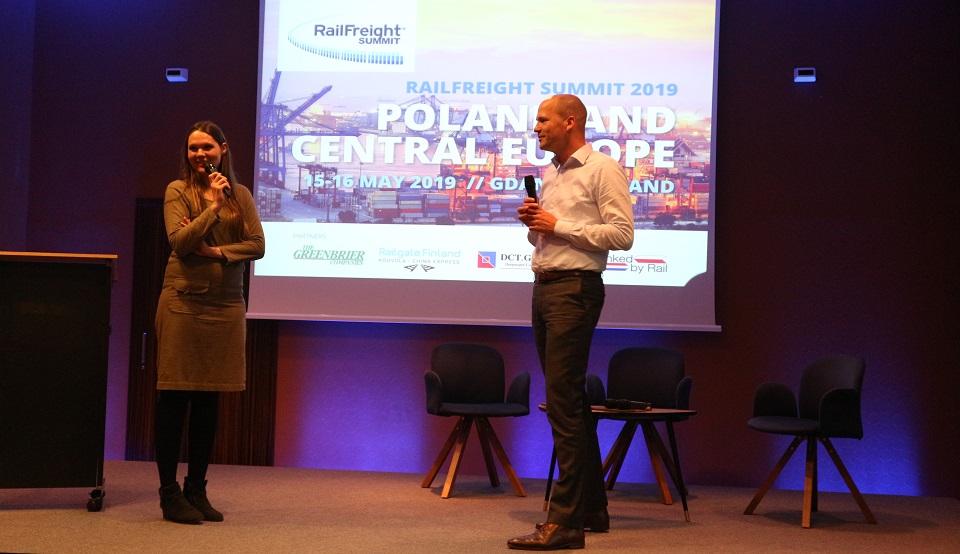
14.45: Anton Sabaleuski, Director for Strategic Development and Investment Policy at Ukrainian Railways (Ukrzaliznytsia), talks about the underestimated opportunities of Ukraine on the Trans-Eurasian route. He says that Ukraine has a developed network of the railway intermodal connections. The customers can book services to transport containers not only to the local seaports like Odesa but to the hinterland terminals in Kyiv, Dnipro and other locations.
At the same time, Ukraine suffers from a lack of transit container traffic. The political tensions with Russia impact this area. The country has almost lost transit containers after 2013. However, Anton Sabaleuski notes that Ukraine is the best solution for transporting containers from China to Southeastern Europe, including Slovakia, Hungary, Austria and even for Northern Italy. According to him, every year business loses 10-15 million Euros due to the inefficient routes via Belarus, Poland and Germany.
Text continues below the picture.

14.25: Vadim Shabarov, Director of Operations at Baltic Rail, represents the company’s rail links between southern Poland and the port of Koper. The main advantage of the Slovenian port is a shorter way to the Middle East and Asia. It allows the shippers to reduce the transit time. For example, the Shanghai – Koper – Wroclaw sea-rail route is faster than the same one via Gdansk or Hamburg.
“We have started in 2011 from nothing. In some ways, it was a very brave decision. However, the volume growth confirms the correctness of our decision,” Vadim Shabarov notes. After a few years, the situation has changed radically. Now, Poland is a hinterland for the port of Koper and its share is growing year by year in the port turnover. You can read more about Baltic Rail here.
Text continues below the picture.
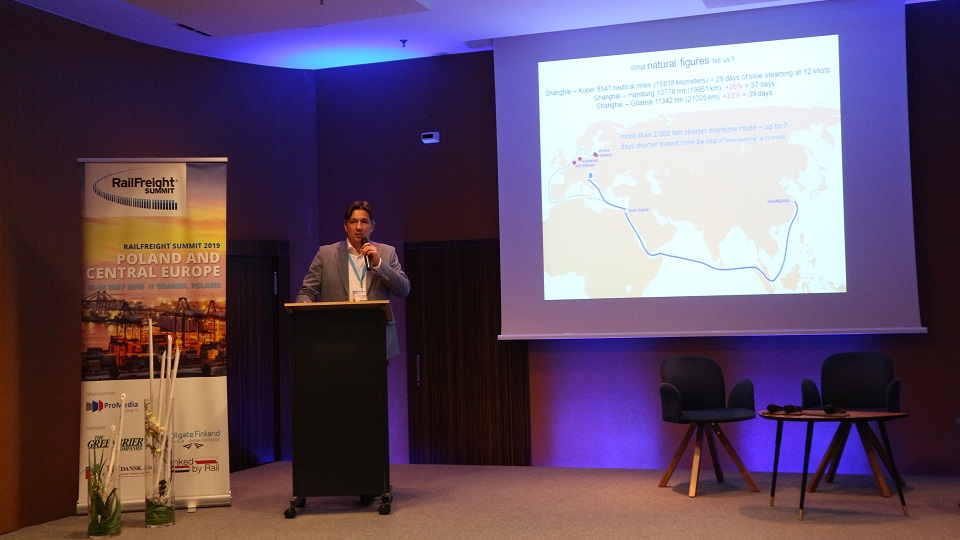
14.10: György Firbás, Logistic Advisor and Consultant from Hungary, gives an insight about his country and its logistics. He starts with a logistics overview of Hungary. The majority of the Hungarian export goes via the port of Koper. According to Firbas, there is no domestic rail service for sea containers. Of the 11 RailFreight Corridors, four touch Hungary. Therefore, the main point of his report is the development of a new intermodal terminal in Zalaegerszeg in the southwestern part of Hungary. The new facility will be located at the crossroad between the route from Budapest and Slovakia to Koper as well. Read more here about it.
Text continues below the picture.

14.00: Questions and answers.
13.40: Alice Defranoux, Global Head of Rail Freight at GEFCO, delivers some details about the rail logistics of the automotive industry. The company operates 4,000 wagons to transport automobiles. It also serves a regular block-train between Wuhan in China and Dourges in France. Alice Defranoux notes the increasing demand for transporting electric vehicles. She also defines the main four challenges for automotive logistics:
- reliable transit time,
- flexibility and agility,
- price robustness,
- safe transport.
Text continues below the picture.

13.30: Tomasz Mioduszewski, Shipping and Forwarding Manager at Metrans Polonia, reports on his company’s intermodal network and service in Central Eastern Europe (CEE). The company’s main focus is to provide rail freight connections between the port of Hamburg and the CEE region. Metrans operates a high-developed network of intermodal terminals.
Text continues below the picture.

13.05: The third session of the RailFreight Summit 2019 starts. Its topic to discuss is the emerging rail markets in Central and Eastern Europe. The first report is delivered by Onno de Jong, Transport & Port Consultant at Ecorys. He makes a presentation about the shift to the east. De Jong notes that Central Eastern Europe (CEE) is well positioned for most developments taking place in production networks and distribution networks for consumption.
As for Poland, it is well-connected with Western Europe. The future intermodal development of the region and Poland especially is in combining and establishing new multimodal solutions. One of them is the UK – Moerdijk – Wroclaw sea-rail route. Also, De Jong stresses that the CEE countries can benefit from linking the TEN-T routes and the Belt and Road Initiative.
Text continues below the picture.

12.30: Networking lunch. Bon Appétit!
11.50: The second panel discussion is devoted to the Dutch-Polish cooperation. The participants are Jakub Kapturzak, Polish Ministry of Infrastructure, Marcel Tijs, Senior Policy Advisor RailFreight at Dutch Ministry of Infrastructure and Adriaan Roest Crollius, Coordinator at Linked by Rail project & Sales Manager at Panteia. The discussion is moderated by Majorie van Leijen. The main topic is again the Brest/Małaszewicze railway border crossing. All the stakeholders are waiting for the new bridge over the Bug River.
Text continues below the picture.
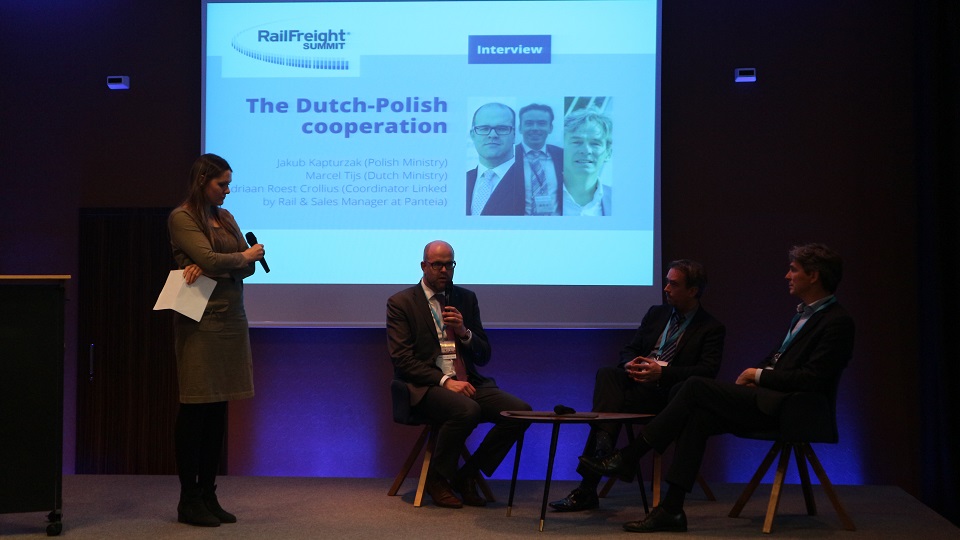
11.30: Adriaan Roest Crollius, Coordinator of the Linked by Rail project & Sales Manager at Panteia, delivers a report on the Dutch-Polish railway connections. He tells about the sharp increase of rail freight transportation between Poland and the Netherlands in 2010-2017. The volumes have almost doubled during this period. Thus, 1.2 million tonnes were transported by rail in 2017. However, there is a huge perspective on future development. Panteia estimated this potential in 2.2 million tonnes that could be shifted from road to rail. It will allow reducing costs by 30 per cent and CO2 emissions by 38 per cent.
At the same time, Roest Crollius notes that a driver shortage in the European countries opens new options for railways. For example, in 2018 Poland had a lack of 100 thousand drivers, Germany – 45 thousand and the Netherlands – 5 thousand drivers. By 2020 the figures will increase up to 190, 150 and around 15 thousand drivers correspondingly. Therefore, the trains could replace trucks in carrying goods between from Poland to both Germany and the Netherlands.
Text continues below the picture.

11.00: Jakub Kapturzak, Director Rail at Polish Ministry of Infrastructure, gives a presentation on the modernisation of the Polish railway network. He describes the rail infrastructure of the Brest/Małaszewicze railway border crossing. It has six tracks of 1,435-millimetre gauge, two tracks of 1,520-millimetre gauge and two single-track bridges. There is also double-track standard gauge connection with Małaszewicze station and single-track broad-gauge connection with Kobylany station. Also, Kapturzak lists several investment projects to be implemented on this border crossing:
- modernisation of Terespol, Małaszewicze and Biała Podlaska in 2017-2020, 560 million Zlotys,
- construction of new Małaszewicze station in 2019-2023, 300 million Zlotys,
- extension of Kobylany station in 2019-2023, 250 million Zlotys,
- construction of the new border bridge in 2019-2025, 140 million Zlotys,
- construction of 9 tracks at Terespol broad-gauge station in 2018-2023, 130 million Zlotys,
- construction of 10 tracks at Biała Podlaska Towarowa station in 2018-2020, 60 million Zlotys.
Text continues below the picture.
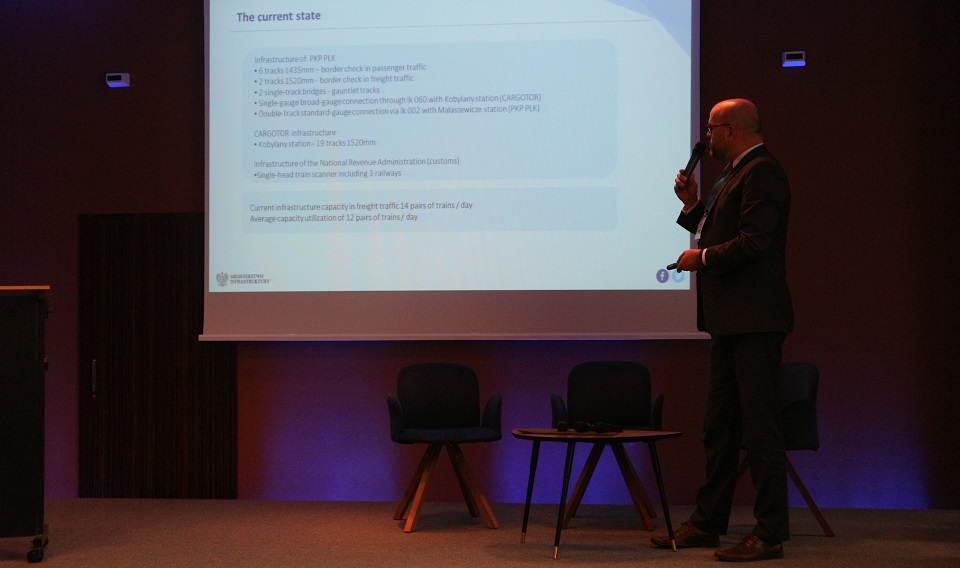
10:30: Coffee break
09.55: The first panel discussion starts. It is devoted to the position of the Central Eastern European ports in the logistics chain. The participants are Erik Nieuwenhuis (Rail Terminal Rzepin), Dominik Landa (DCT Gdansk), Tadeusz Klimczyk (PCC Intermodal) and Marek Tarczyński (Polska Izba Spedycji i Logistyki, PISIL). The moderator is Onno de Jong from Ecorys. The rail intermodal transportation is developing in Poland. “We have started from one train per week from our PCC Rokita chemical plant to the port of Świnoujście. At this moment we have 156 trains per week. As you can see, the intermodal market is developing very fast,” Klimczyk notes.
The main question to be discussed is the rail bottlenecks. Landa notices that the Polish government and rail infrastructure manager PKP PLK are investing much in the upgrading of rail infrastructure. Some sections are modernised but other ones remain in the same condition. Such a difference creates additional obstacles for rail operators, shippers and forwarders. Tarczyński stresses that there is also a lack of custom proceeding that makes train traffic slower.
The other aspect is the intermodal underdevelopment of Eastern Poland. Klimczyk notes that the western and southern parts of Poland have a lot of intermodal terminals. For example, there are seven terminals in Poznan and its surroundings in a radius of 70 kilometres. Meanwhile, the eastern and northeastern parts have a few of them. According to Klimczyk, PCC Intermodal intends to construct a new intermodal facility in northeastern Poland, close to Lithuania by 2023.
Text continues below the picture.
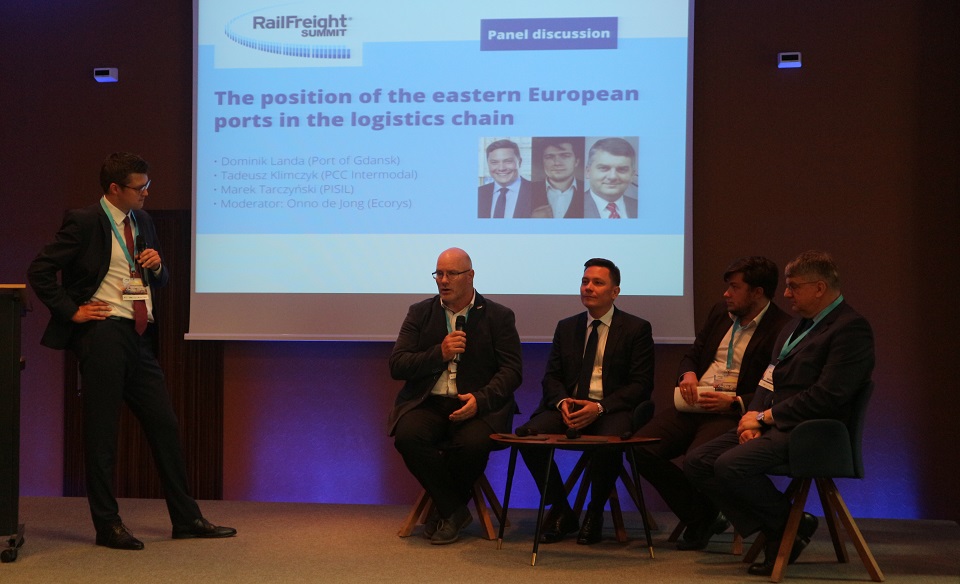
09.35: Dominik Landa, Commercial Director at DCT Gdansk, opens the second session of the RailFreight Summit 2019. He gives a presentation about DCT Gdansk terminal, the largest container facility in Poland and in the Baltic Sea Region.
Text continues below the video.
He tells the history of the terminal establishment. The main advantage of DCT Gdansk is all-year ice-free access with no depth restrictions. The Approach Fairway is 17 metres deep. The annual capacity of the terminal is 3.25 million TEUs. “We are the number two in Europe and number seven in the world among the fastest growing terminals,” Landa notes.
DCT Gdansk serves over 500 block trains every month. The connections are provided by its partners – PCC Intermodal, PKP Cargo, Lotos Kolej, Rail Cargo Group and others. One of the successful rail freight links to DCT Gdansk is the train to Czechia (Ostrava) and Slovakia (Zilina). Dominik Landa also mentions the rail connection to Belarus. It has good opportunities for future growth.
The terminal has a development programme. According to Landa, it includes yard expansion, berth prolongation, installation of new cranes and track extension. Currently, DCT Gdansk has four tracks, by the end of 2020 this number will increase up to seven ones.
Text continues below the picture.
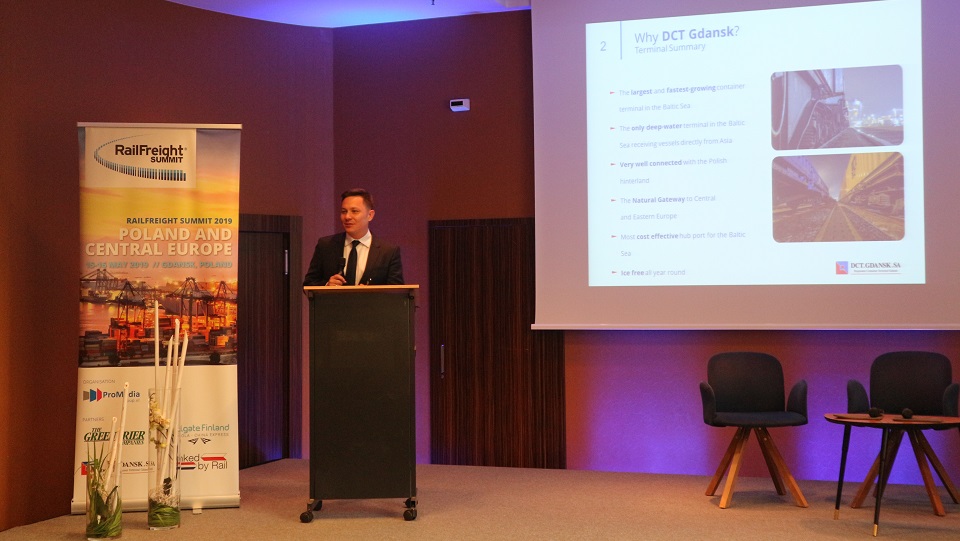
09.20: Majorie van Leijen, the summit’s moderator and editor of RailFreight, inaugurates the second day of discussions. Two sessions are scheduled for today: one is about intermodal hubs in Poland, another is dedicated to the emerging rail markets in Central Eastern Europe.

Read more about the RailFreight Summit 2018:
You just read one of our premium articles free of charge
Want full access? Take advantage of our exclusive offer




